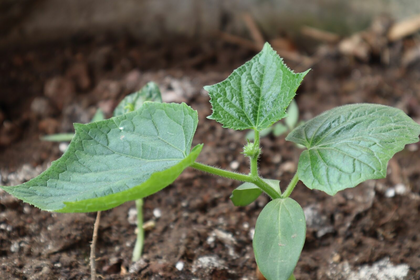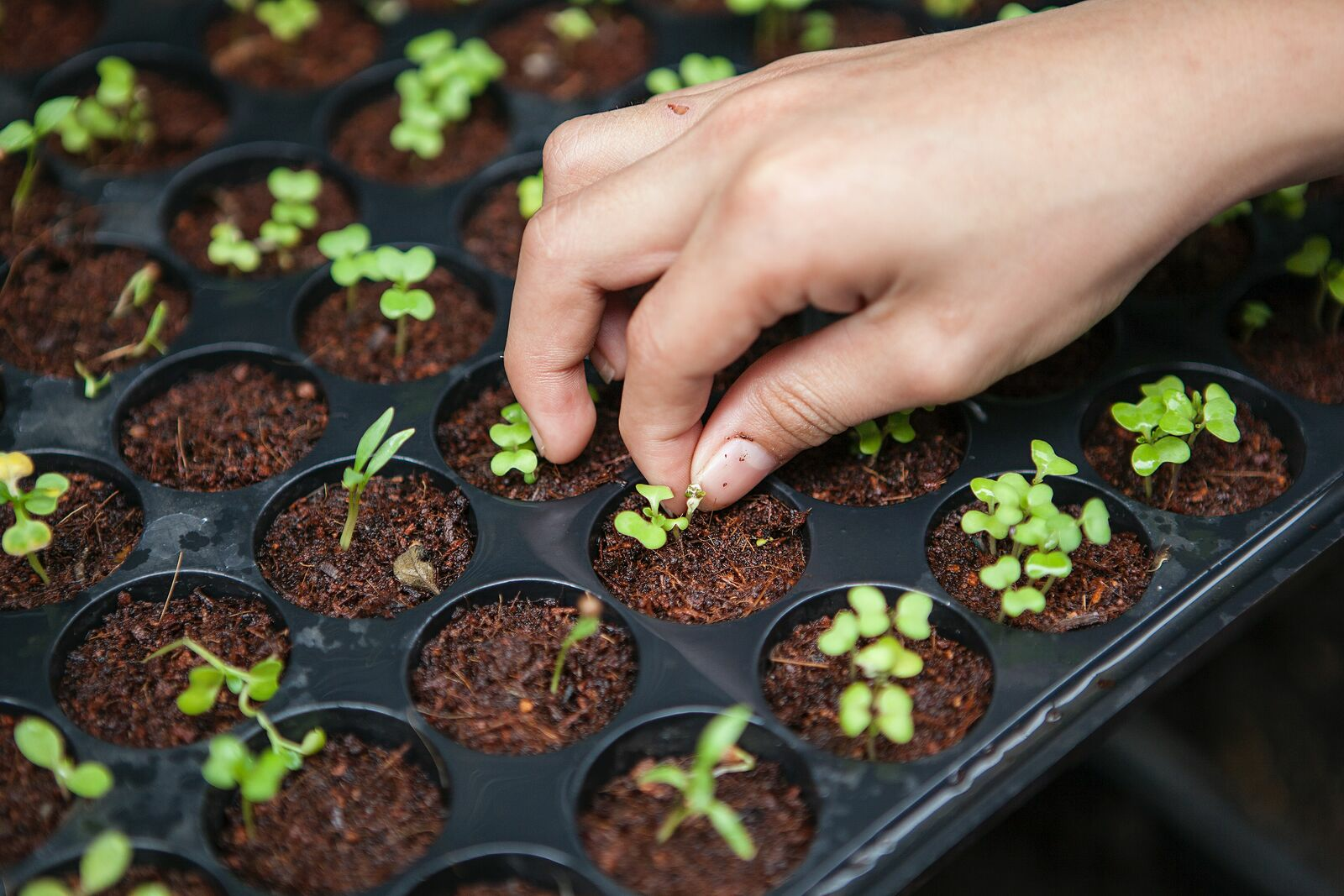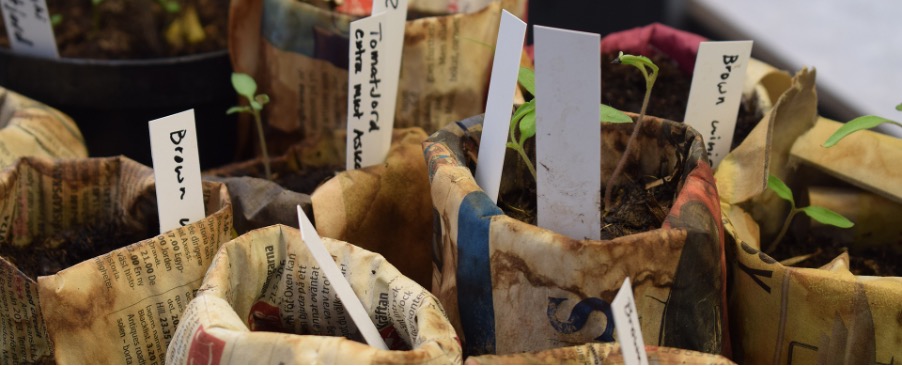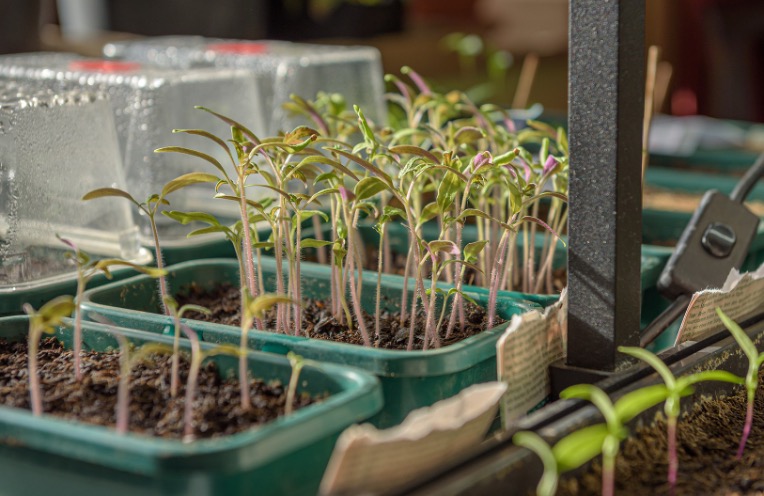
Germination & Sowing
Pre-planting cucumbers: How to get healthy young plants

There is a large selection of growing containers. From professional growing plates to homemade growing pots made from toilet paper or egg cartons, there are many options for growing your seedlings. In this article, you can find out which growing pots are available and what advantages and disadvantages they offer.
You can reuse plastic propagation trays and Quickpot propagation trays or multi-pot trays every year. This saves you having to buy or make your own growing pots. With propagation trays, you can either fill the tray directly with special propagation soil and sow your seeds. Alternatively, you can also use the seed tray as a base for your seed pots. This makes it easy to transport and cover your seedlings. You can find out more about potting compost and how to make it under Make your own potting compost.
Quickpot growing trays are often used in nurseries as they allow you to sow a large number of seeds quickly. They therefore offer you an advantage if you want to propagate a large number of plants. However, depending on their size, seed trays and multi-pot trays can take up a lot of space and don't always fit on the windowsill. You should therefore think about whether you have a suitable place for the trays beforehand.
Swelling tablets or pots are usually made of coconut fibers and are a very simple and quick method of pre-sowing seeds. The pre-soaking pots only need to be pre-soaked in water. You can then sow the seeds directly. When buying soaker trays, make sure that they do not contain peat.
Growing pots made from coconut fibers are also available to buy. However, you have to fill these with soil yourself before you can put your seeds in the soil. As with the swelling tablets, you can also plant these pots directly into the soil. There are also plant pots made from hemp fibers, which are also biodegradable. However, they take a little longer to decompose, around 10 weeks. This makes them unsuitable for planting in.
Normal clay and plastic pots can of course also be used for sowing. In general, you should always make sure that the water can drain out of the growing pots. This is because your seedlings should not stand in water, as this can quickly lead to mold. You can find out what else you should consider when growing in our article Growing vegetable plants.

Growing pots are easy to make yourself with a little time and planning. This will save you money on buying plant pots and do something good for the environment. In order to have your pots available in good time, you should start collecting egg cartons and toilet paper rolls early on. Otherwise you won't end up with enough containers for your seeds.
Egg cartons and eggshells are easy ways to propagate small plants without having to spend a lot of time making seed pots. Just make sure you remove the labels first. You can then simply add some soil to your egg cartons and sow your seeds. You should clean the eggshells beforehand and carefully poke a hole in the bottom before filling them with soil. This will allow excess water to drain away. However, egg cartons and eggshells do not offer much space for your plants. You should therefore sow crops that do not form deep roots (e.g. lettuce, cress). As soon as your seedlings are big enough, you can simply place them in the soil with the carton or tray.
Toilet paper rolls or kitchen rolls can also be planted directly in the soil with your seedlings and will then be decomposed by soil organisms. To make your own growing containers from toilet paper rolls, all you need is a few toilet paper rolls and a pair of scissors. Simply cut 1-2 cm into one edge of the rolls in four places and then fold the four pieces into each other.
You can make growing pots from newspaper in a similar way. The easiest way to do this is with a paper pot press, but you can also make your own pots using a bottle or jars. To do this, take a newspaper and cut it in half. Then wrap the newspaper around the bottle or jar so that a piece of newspaper sticks out at the end. It's best to wrap the newspaper around 2-3 times so that your pots are nice and stable. The protruding end is cut into four sides and folded into each other, just like the toilet rolls. Optionally, depending on the stability of your homemade pots, you can tie some string around the newspaper.

Used plastic trays, yoghurt pots, tetrapacks or other containers that would otherwise end up in the bin can easily be used as growing pots. However, you should clean them well before use to prevent diseases from developing. You should also make sure that excess water can drain away so that your seedlings don't stand in water. They don't like that.
With a soil pot or soil ball press, you save yourself any growing container, as you make your own soil balls/soil pots. All you need is a base for your pots. This makes the soil pot press a plastic-free alternative to conventional growing containers.

In our library you will find information on the individual varieties with sowing dates, cultivation period and tips on planting and harvesting. You will also find good and bad neighbours to help you plan a mixed crop.
Learn more in the lexicon nowThere are a few things to bear in mind when growing young plants. Here are a few tools that can help you with pre-cultivation.
A propagator, also known as a propagator, is a good way to ensure a consistent temperature and humidity for your seedlings. These factors are particularly important when growing young plants. You can buy propagators, but you can also easily make your own with some transparent film and fruit crates, a few plastic trays, or simply with a few glass jars that you stack on top of each other. Of course, the glass jars take up a bit of space, but are well suited for individual plants.
If you use a propagator or other type of mini-greenhouse for your seedlings, you should remove the cover at least once a day for 10 minutes. Otherwise mold will easily develop. The cover is particularly important until germination. As your plants like it a little cooler afterwards, they often no longer need the cover after germination.

A constant temperature is very important for your young plants. Maintaining this is not so easy if the temperature in your rooms fluctuates day and night. Heating mats can help to keep the temperature evenly high. A heating mat is particularly suitable for heat-loving nightshade and pumpkin plants, for example, if you grow them in an unheated greenhouse. However, a heating mat is often superfluous on the windowsill, as it is usually warm enough here anyway due to the heating.
You first need to find space in your home for a growing shelf. However, if you can find a place, you have the opportunity to grow a lot of young plants in a small space. However, you should also make sure that your plants get enough light everywhere.
Light is still very scarce, especially in winter. However, most plants need more light than is available during these months. Therefore, plant lamps can help you to prevent plants from going to seed - i.e. growing weak and thin because there is not enough light.
When choosing your planters, you should also pay attention to how much space your plants need. Some plants such as cucumber, zucchini and pumpkin need more space than lettuce, for example, while tomatoes and celery like to grow deeper roots. The smaller the pot, the sooner you will also need to prick out and repot your plants. You can find out more about when you should start which plants in advance in our Vegetable planting calendar article.
Mold on the potting soil or on the seed pots is a sign of too much moisture. Keeping your seedlings moist is important for their growth. However, if you are using a cover or a propagator, you should air the lid at least once a day for 10 minutes.
Another reason for mold can be germs in the potting soil. Although store-bought potting compost should be germ-free, it can sometimes happen that germs are still present. This is the case, for example, if the soil has been outside for a while or the quality of the potting soil is not good. If you make your own potting compost, you should sterilize it in the oven or microwave before use.
Plastic growing pots can also develop mold if you have not cleaned them properly. Growing pots made from newspaper, toilet paper rolls and egg cartons are particularly prone to mold. This is because they soak up the irrigation water and mold spores from the air like to settle there.
If mold does form, you should ventilate your plants well and stop watering them. This will allow the soil to almost dry out and prevent the fungi from spreading. Horsetail tea is also a good remedy for mold. You can find out how to make your own tea in our article on making your own horsetail tea. If you then spray your plants with it regularly, the mold should disappear on its own.
If you have any questions or comments, please write to us at [email protected]. Would you like to receive helpful gardening tips all year round and plan your own beds optimally? Then register here or download the Fryd app for Android or iOS.
Fryd - your digital bed planner
Cover image by Joshua Lanzarini on Unsplash.

Marielena studies agricultural and environmental sciences. She gardens at home and at an allotment and likes to try out new things. She loves to spend time in nature during gardening, bird watching and photographing, hiking and camping.
Learn more
A horror for anyone who values a well-tended garden or patio. I think the thistle is simply beautiful. The grids on the boxes are a protection so that my cat doesn't abuse them as a toilet😊. Later, when there's something inside, he doesn't go in any more

Es hat 6 Tage gedauert, bis dieser Wasabino-Salat gekeimt ist. Ich bin gespannt auf diesen würzigen Salat 🥬🥗. #asia-salat #Wasabino

Liked 6 times
Yeah, yeah and yeah 😁😁😁 I'm so proud, the #asparagus is peeking out! Meanwhile the 2nd stalk 🥰 Another 4 years until the harvest 🤣
Show 1 answerWhat are the advantages of growing trays and Quickpot growing plates?
Growing trays and Quickpot growing plates are well suited for sowing large quantities, as they are reusable and allow efficient use of space.
Can seed pots be planted directly in the soil?
Yes, spring pots and pots made from biodegradable materials such as coconut or hemp fibers can be planted directly in the soil, which makes transplanting easier.
How can I make my own growing pots?
Growing pots can be easily made from everyday materials such as egg cartons, toilet paper rolls or newspaper, which is a cost-effective and environmentally friendly option.
What can I do if growing pots get moldy?
If mold forms, watering should be reduced and the affected plants and pots should be treated with a fungicidal tea such as horsetail.